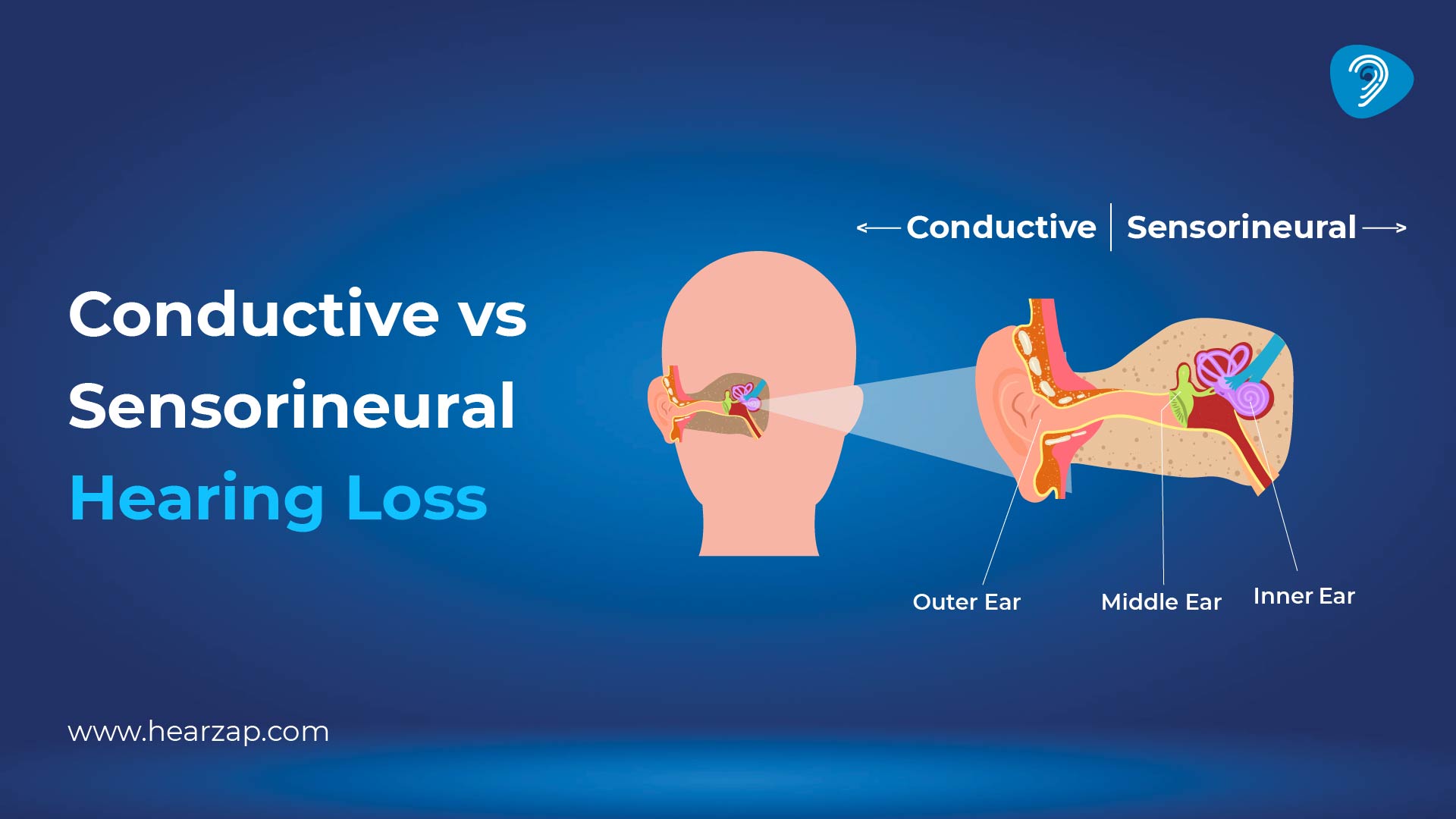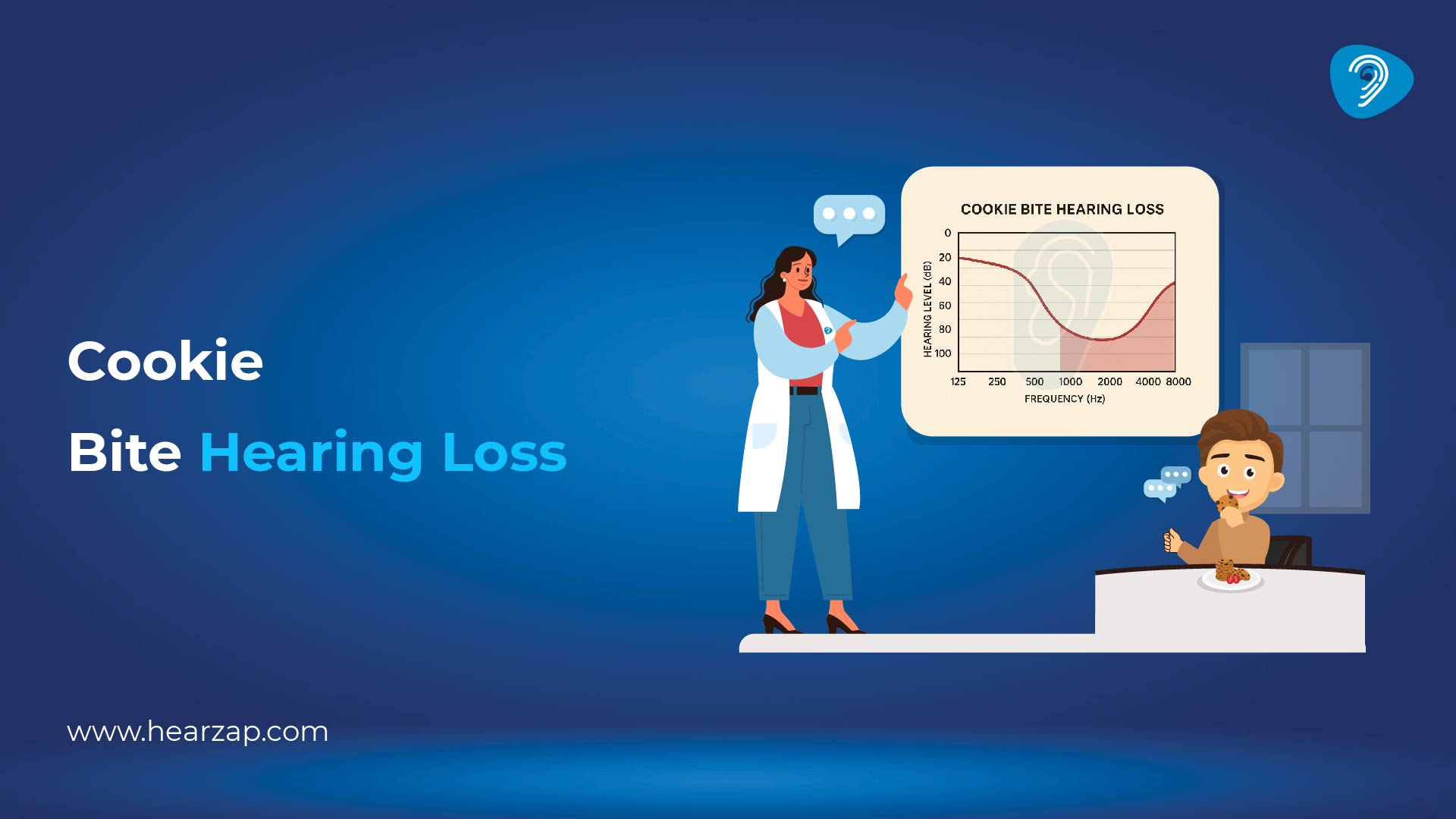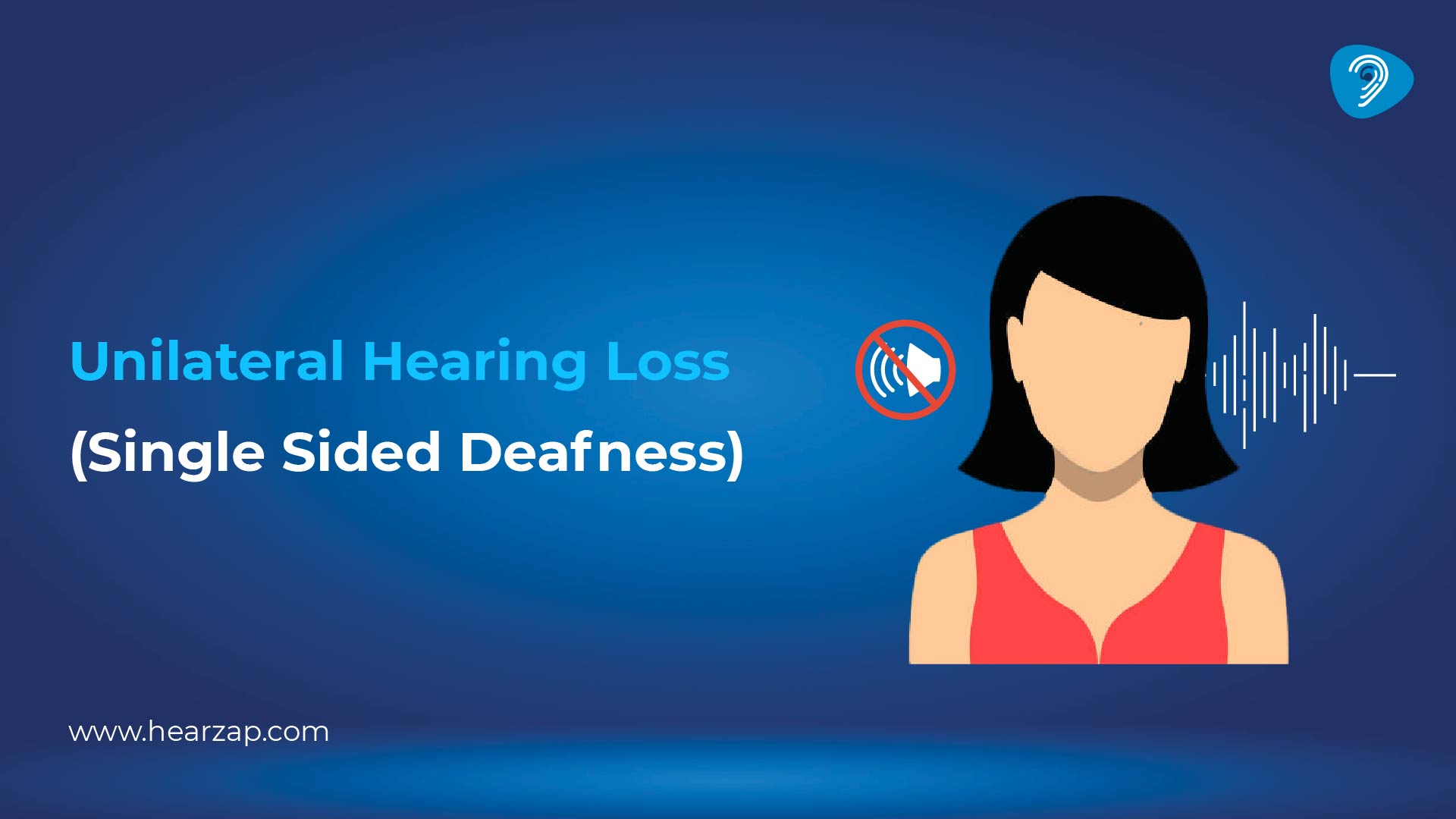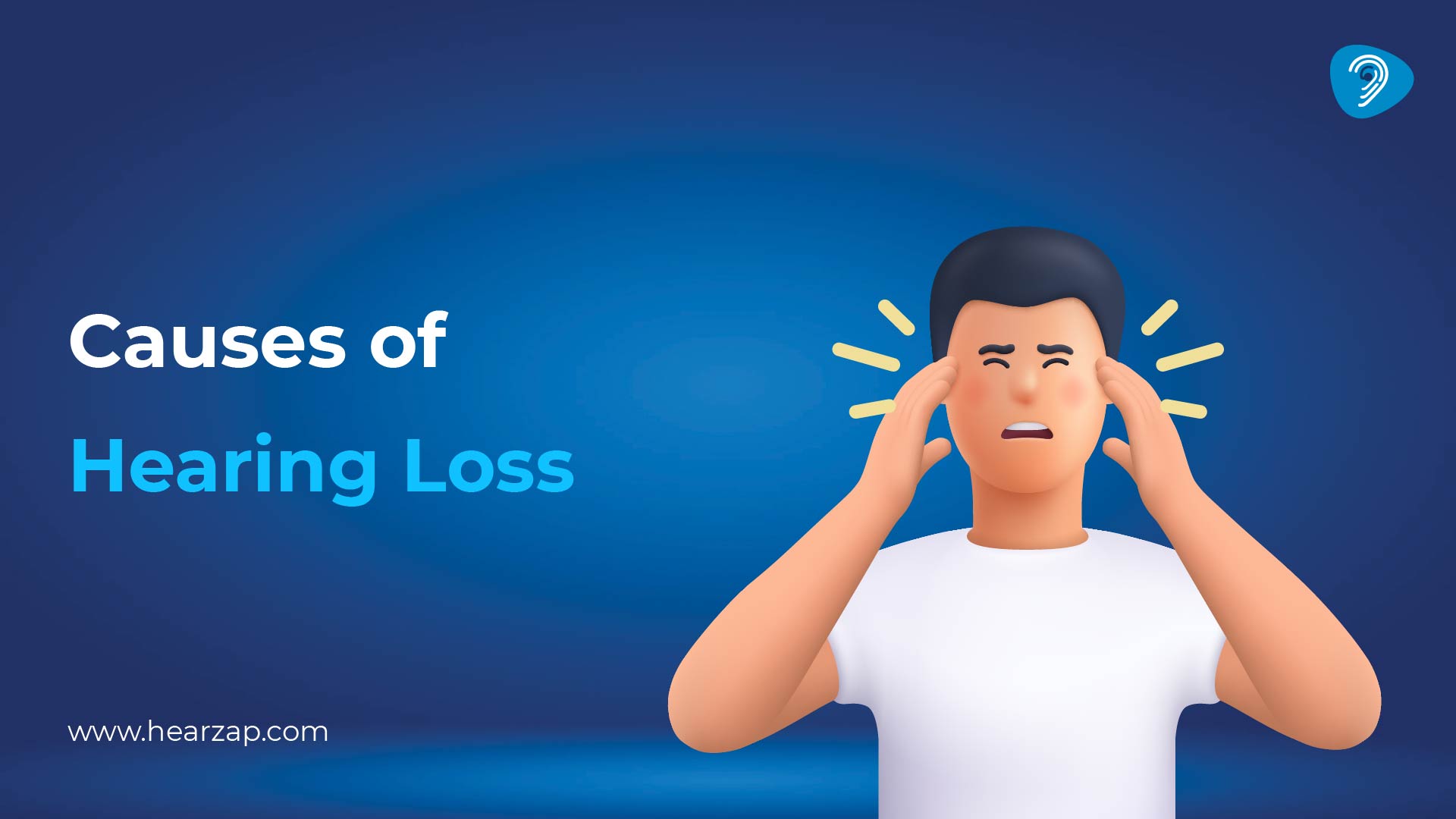HEARING LOSS
Conductive vs Sensorineural Hearing Loss: What’s the Difference?
By Team Hearzap | Oct. 15, 2025

Hearing problems are common, but not all hearing problems are the same. Two broad patterns show up in clinics: Conductive vs Sensorineural Hearing Loss. Understanding the difference between conductive and sensorineural hearing loss helps you make sense of symptoms, tests, and next steps. In short, one type blocks sound on its way to the inner ear, while the other relates to inner ear or nerve changes. This guide explains both in clear language, so you can talk to a professional with confidence.
What is Conductive Hearing Loss?
Conductive hearing loss happens when something reduces the movement of sound through the outer or middle ear. The inner ear may be healthy, but the sound never reaches it at full strength. People often describe it as listening through a door or with cotton in the ear.
Typical causes of conductive hearing loss include:
- Earwax buildup that plugs the canal
- Fluid in the middle ear after a cold or allergies
- Ear infections that create swelling or fluid
- A hole in the eardrum from injury or infection
- Stiffness or abnormalities in the tiny ear bones
- Objects stuck in the ear canal
Common Symptoms of Conductive Hearing Loss
- Sounds seem softer, dull, or muffled on the affected side
- You may notice better hearing in one ear than the other
- Turning up the TV or radio volume often helps
- Your own voice may sound different or unusually loud
How is Conductive Hearing Loss Treated?
Treatment focuses on removing the blockage or fixing the mechanical problem. Options may include:
- Professional earwax removal
- Medicines to treat infections or reduce swelling
- Minor procedures to drain persistent fluid
- Repair of the eardrum or middle ear bones, when needed
- Fitting hearing aids if the problem cannot be fully corrected
Many people see meaningful improvement once the cause is addressed, especially when care is timely and guided by an ENT or audiologist.
What is Sensorineural Hearing Loss?
Sensorineural hearing loss refers to changes in the inner ear (cochlea) or the hearing nerve. The pathway that converts sound into nerve signals becomes less efficient. It is the most common form of long-term hearing impairment in adults.
Common causes include:
- Age-related change in the inner ear (presbycusis)
- Long exposure to loud noise at work or leisure
- Genetic factors or family history
- Head injuries
- Certain medicines that may affect the inner ear (ototoxic drugs)
- Illnesses that can damage the inner ear
Common Symptoms of Sensorineural Hearing Loss
- Speech seems unclear, especially in busy restaurants or markets
- Friends sound like they are mumbling
- Trouble noticing high-pitched sounds like birds or timers
- Ringing in the ears, also called tinnitus
- You may feel that raising the volume helps less than expected
How is Sensorineural Hearing Loss Treated?
Changes in the inner ear are usually not reversible, but support can make listening easier:
- Modern hearing aids amplify speech and reduce background noise
- Cochlear implants may help in severe cases after a specialist assessment
- Assistive devices like TV streamers or remote microphones can help in groups
- Communication tactics, such as facing the speaker and good lighting, make a difference
- Early assessment and a personalised plan slow the impact on day-to-day life
Timely evaluation is especially useful when people notice mild sensorineural hearing loss, because small adjustments and training can protect communication at work and home. Some people use the term sensorineural deafness for severe or profound cases, but many still benefit from technology and therapy.
Key Differences Between Conductive and Sensorineural Hearing Loss
A side-by-side view of conductive hearing loss vs sensorineural hearing loss makes the contrast clearer.
In simple terms, conductive problems lower the strength of sound before it reaches the inner ear, while sensorineural problems change how sound is processed once it gets there. Both can feel frustrating, but they call for different plans.
If you are weighing the difference between conductive and sensorineural hearing loss, remember that the right tests point the way. Even when two people complain of the same “muffled” feeling, the source can be very different.
Think of a blocked ear after swimming or on a flight. Until pressure or wax clears, the world sounds faint and dull: a classic conductive picture. Now imagine hearing a colleague, yet missing crisp consonants even when the voice is loud. That pattern points toward a sensorineural change where clarity, not just loudness, is the challenge.
Simple habits help. Sit where you can see faces, reduce background noise, and ask people to get your attention. Tweaks plus devices make conversations easier at home and work.
After testing, your clinician may say the result looks conductive, sensorineural, or mixed. Mixed patterns happen, for example, inner ear change plus fluid or wax. Treating the conductive part still brings a useful lift.
How to Know Which Type You Have?
The surest route is a professional hearing test. An audiologist or ENT uses a set of quick, painless checks to map your hearing and the ear’s mechanics. When you are booking hearing test appointment, you may see several items on the schedule:
- Pure tone audiometry checks the softest sounds you can hear at different pitches
- Tympanometry shows how the eardrum moves and whether there is fluid or pressure
- Speech tests measure understanding of words and sentences
- Tuning fork checks can suggest whether a problem is conductive or sensorineural
- Otoscopy lets the clinician look at the canal and eardrum
Self-diagnosis is rarely reliable. The same symptom can arise from earwax, from noise exposure, or from both. Getting the profile right saves time and steers you to the most helpful support.
When to See a Doctor
Do not wait if you notice any of these warning signs:
- Sudden change in hearing in one or both ears
- Persistent ear pain, drainage, or a feeling of fullness
- Dizziness along with hearing loss
- Ringing in one ear that does not settle
- A quick drop in hearing over days or weeks
- New trouble understanding speech in quiet settings
Early advice keeps options open. Even when the change cannot be reversed, practical steps, technology, and coaching can improve day-to-day communication.
Regular follow-ups keep small issues from becoming bigger. Get a complete diagnosis at your nearest Hearzap store or book a convenient home visit today!
Conclusion
The main contrast between the two types is the site of the problem. Conductive issues block sound before it reaches the inner ear. Sensorineural issues involve the inner ear or nerve. Knowing this difference shapes the plan: remove the blockage when possible, or support the inner ear with technology and listening strategies. If you have concerns, a timely hearing test and a conversation with a clinician will help you choose between medical care, hearing aids, or other tools suited to your situation.
Staying informed reduces worry. Small habits like protecting your ears from loud noise, treating ear infections promptly, and planning regular checks can protect hearing for years to come.
FAQs
How to confirm sensorineural hearing loss?
A qualified professional confirms it with a full assessment that usually includes pure tone testing, speech understanding, and a check of middle ear function. The pattern on the audiogram, along with your history, points to a sensorineural type.
What are three causes of sensorineural hearing loss?
Age-related inner ear changes, long exposure to loud noise, and certain medicines that may affect the inner ear are three common reasons. Genetics, head injury, and some illnesses can also play a role.
What is the most common cause of conductive hearing loss?
In everyday practice, earwax and fluid in the middle ear are very common reasons. In some people, infections or a small hole in the eardrum are involved.
Can you still hear with sensorineural hearing loss?
Most people do hear, but clarity is reduced, especially in background noise. Many improve communication with carefully fitted devices and helpful strategies after assessment.
Related Blogs

Cookie Bite Hearing Loss: Meaning, Causes, and Treatment Options

Unilateral Hearing Loss (Single-Sided Deafness)

Causes of Hearing Loss
Contact us
We are here for all your hearing needs, from hearing tests to hearing aids. Fill out the form below, and we will give you a call soon.
Please enter a valid mobile number with 10 digits.
Recent Blogs
By None | Dec. 16, 2025
By None | Dec. 15, 2025
By None | Dec. 13, 2025
By None | Dec. 12, 2025
By None | Dec. 11, 2025









